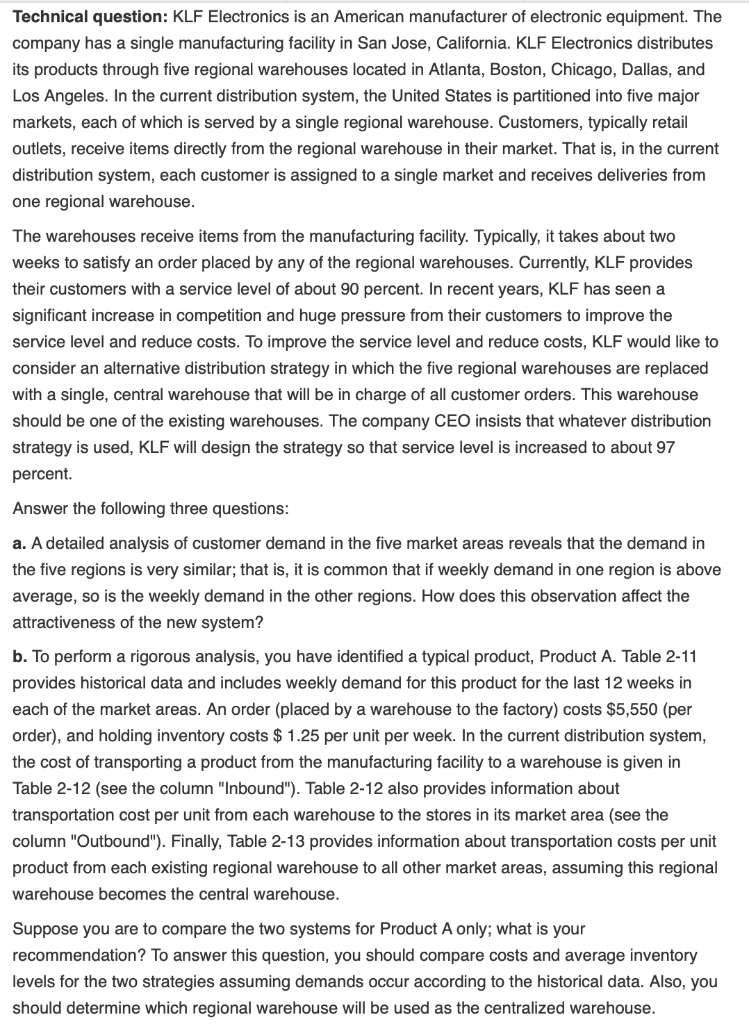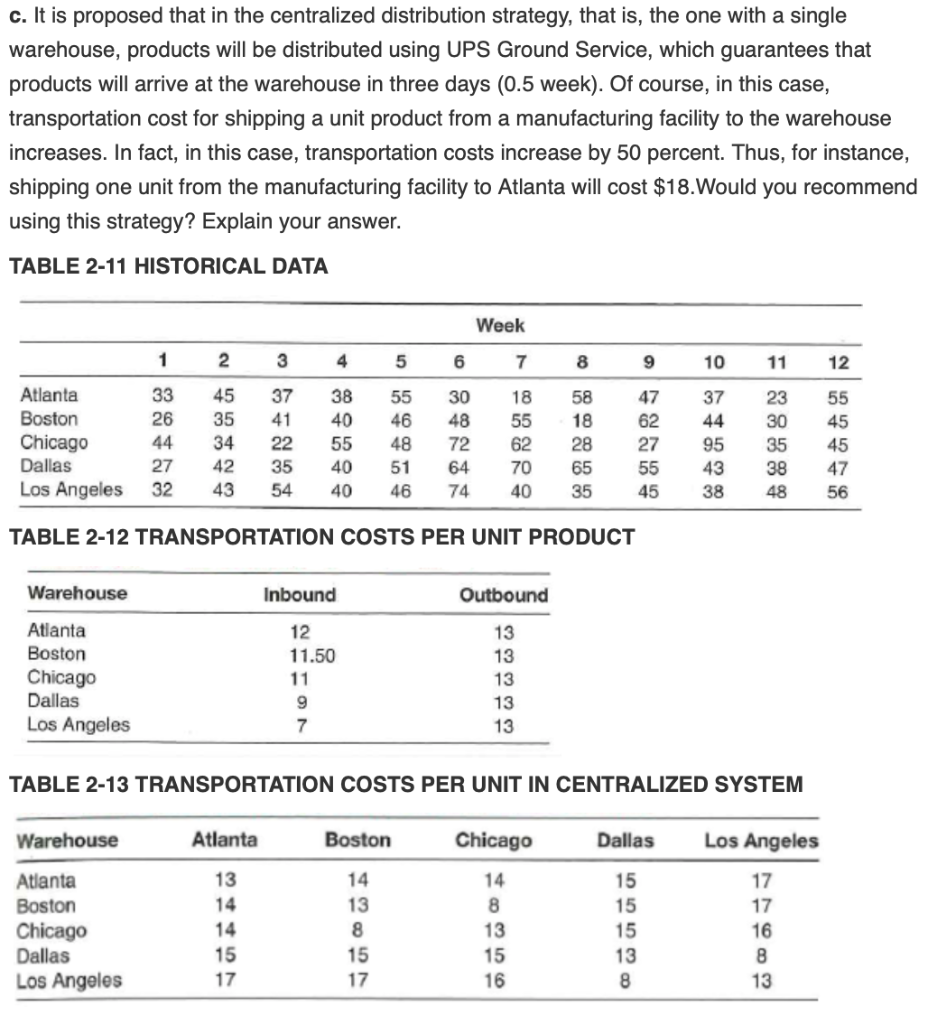

Technical question: KLF Electronics is an American manufacturer of electronic equipment. The company has a single manufacturing facility in San Jose, California. KLF Electronics distributes its products through five regional warehouses located in Atlanta, Boston, Chicago, Dallas, and Los Angeles. In the current distribution system, the United States is partitioned into five major markets, each of which is served by a single regional warehouse. Customers, typically retail outlets, receive items directly from the regional warehouse in their market. That is, in the current distribution system, each customer is assigned to a single market and receives deliveries from one regional warehouse. The warehouses receive items from the manufacturing facility. Typically, it takes about two weeks to satisfy an order placed by any of the regional warehouses. Currently, KLF provides their customers with a service level of about 90 percent. In recent years, KLF has seen a significant increase in competition and huge pressure from their customers to improve the service level and reduce costs. To improve the service level and reduce costs, KLF would like to consider an alternative distribution strategy in which the five regional warehouses are replaced with a single, central warehouse that will be in charge of all customer orders. This warehouse should be one of the existing warehouses. The company CEO insists that whatever distribution strategy is used, KLF will design the strategy so that service level is increased to about 97 percent Answer the following three questions: a. A detailed analysis of customer demand in the five market areas reveals that the demand in the five regions is very similar; that is, it is common that if weekly demand in one region is above average, so is the weekly demand in the other regions. How does this observation affect the attractiveness of the new system? b. To perform a rigorous analysis, you have identified a typical product, Product A. Table 2-11 provides historical data and includes weekly demand for this product for the last 12 weeks in each of the market areas. An order (placed by a warehouse to the factory) costs $5,550 (per order), and holding inventory costs $ 1.25 per unit per week. In the current distribution system, the cost of transporting a product from the manufacturing facility to a warehouse is given in Table 2-12 (see the column "Inbound"). Table 2-12 also provides information about transportation cost per unit from each warehouse to the stores in its market area (see the column "Outbound"). Finally, Table 2-13 provides information about transportation costs per unit product from each existing regional warehouse to all other market areas, assuming this regional warehouse becomes the central warehouse. Suppose you are to compare the two systems for Product A only; what is your recommendation? To answer this question, you should compare costs and average inventory levels for the two strategies assuming demands occur according to the historical data. Also, you should determine which regional warehouse will be used as the centralized warehouse. c. It is proposed that in the centralized distribution strategy, that is, the one with a single warehouse, products will be distributed using UPS Ground Service, which guarantees that products will arrive at the warehouse in three days (0.5 week). Of course, in this case, transportation cost for shipping a unit product from a manufacturing facility to the warehouse increases. In fact, in this case, transportation costs increase by 50 percent. Thus, for instance, shipping one unit from the manufacturing facility to Atlanta will cost $18. Would you recommend using this strategy? Explain your answer. TABLE 2-11 HISTORICAL DATA Atlanta Boston Chicago Dallas Los Angeles 1 33 26 44 27 32 2 45 35 34 42 43 3 37 41 22 35 54 4 38 40 55 40 40 5 55 46 48 51 46 Week 6 7 30 18 48 55 72 6 2 64 70 74 40 8 58 18 28 65 35 9 10 11 12 47 37 23 55 62 44 3 0 45 27 95 35 45 55 43 38 47 45 384856 TABLE 2-12 TRANSPORTATION COSTS PER UNIT PRODUCT Warehouse Inbound Outbound 12 11.50 13 Atlanta Boston Chicago Dallas Los Angeles 11 TABLE 2-13 TRANSPORTATION COSTS PER UNIT IN CENTRALIZED SYSTEM Warehouse Atlanta Boston Chicago Dallas Los Angeles Atlanta Boston Chicago Dallas Los Angeles Technical question: KLF Electronics is an American manufacturer of electronic equipment. The company has a single manufacturing facility in San Jose, California. KLF Electronics distributes its products through five regional warehouses located in Atlanta, Boston, Chicago, Dallas, and Los Angeles. In the current distribution system, the United States is partitioned into five major markets, each of which is served by a single regional warehouse. Customers, typically retail outlets, receive items directly from the regional warehouse in their market. That is, in the current distribution system, each customer is assigned to a single market and receives deliveries from one regional warehouse. The warehouses receive items from the manufacturing facility. Typically, it takes about two weeks to satisfy an order placed by any of the regional warehouses. Currently, KLF provides their customers with a service level of about 90 percent. In recent years, KLF has seen a significant increase in competition and huge pressure from their customers to improve the service level and reduce costs. To improve the service level and reduce costs, KLF would like to consider an alternative distribution strategy in which the five regional warehouses are replaced with a single, central warehouse that will be in charge of all customer orders. This warehouse should be one of the existing warehouses. The company CEO insists that whatever distribution strategy is used, KLF will design the strategy so that service level is increased to about 97 percent Answer the following three questions: a. A detailed analysis of customer demand in the five market areas reveals that the demand in the five regions is very similar; that is, it is common that if weekly demand in one region is above average, so is the weekly demand in the other regions. How does this observation affect the attractiveness of the new system? b. To perform a rigorous analysis, you have identified a typical product, Product A. Table 2-11 provides historical data and includes weekly demand for this product for the last 12 weeks in each of the market areas. An order (placed by a warehouse to the factory) costs $5,550 (per order), and holding inventory costs $ 1.25 per unit per week. In the current distribution system, the cost of transporting a product from the manufacturing facility to a warehouse is given in Table 2-12 (see the column "Inbound"). Table 2-12 also provides information about transportation cost per unit from each warehouse to the stores in its market area (see the column "Outbound"). Finally, Table 2-13 provides information about transportation costs per unit product from each existing regional warehouse to all other market areas, assuming this regional warehouse becomes the central warehouse. Suppose you are to compare the two systems for Product A only; what is your recommendation? To answer this question, you should compare costs and average inventory levels for the two strategies assuming demands occur according to the historical data. Also, you should determine which regional warehouse will be used as the centralized warehouse. c. It is proposed that in the centralized distribution strategy, that is, the one with a single warehouse, products will be distributed using UPS Ground Service, which guarantees that products will arrive at the warehouse in three days (0.5 week). Of course, in this case, transportation cost for shipping a unit product from a manufacturing facility to the warehouse increases. In fact, in this case, transportation costs increase by 50 percent. Thus, for instance, shipping one unit from the manufacturing facility to Atlanta will cost $18. Would you recommend using this strategy? Explain your answer. TABLE 2-11 HISTORICAL DATA Atlanta Boston Chicago Dallas Los Angeles 1 33 26 44 27 32 2 45 35 34 42 43 3 37 41 22 35 54 4 38 40 55 40 40 5 55 46 48 51 46 Week 6 7 30 18 48 55 72 6 2 64 70 74 40 8 58 18 28 65 35 9 10 11 12 47 37 23 55 62 44 3 0 45 27 95 35 45 55 43 38 47 45 384856 TABLE 2-12 TRANSPORTATION COSTS PER UNIT PRODUCT Warehouse Inbound Outbound 12 11.50 13 Atlanta Boston Chicago Dallas Los Angeles 11 TABLE 2-13 TRANSPORTATION COSTS PER UNIT IN CENTRALIZED SYSTEM Warehouse Atlanta Boston Chicago Dallas Los Angeles Atlanta Boston Chicago Dallas Los Angeles








